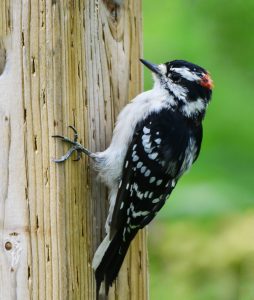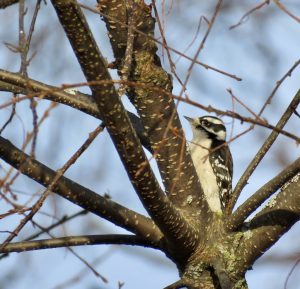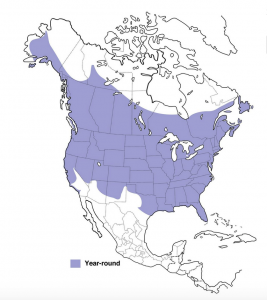Welcome to “Bird of the Month”. Each month we will be presenting a different bird species. We hope you enjoy it.
Downy Woodpecker
(Picoides pubescens)


The Downy Woodpecker (Picoides pubescens) is the smallest North American woodpecker, weighing in at around 1.0 ounce (yes, that’s right – ounce), and only 6.75 inches in length. In comparison, the Hairy Woodpecker, which is most often confused with the Downy Woodpecker, and can also be found in the Homer Area, weighs in at around 2.3 to 2.5 ounces, and measures 9.25 inches in length. The Hairy Woodpecker has a longer, sharper bill, and lacks the black spots on the white outer tail feathers that are found on the Downy.
The Downy Woodpecker can be found and enjoyed in every state. In Homer, you want to search for the Downy Woodpecker in forested areas – after all, woodpeckers like trees, but remember, don’t ignore the small branches on bushes for the Downy.

Source: Cornell Lab of Ornithology – https://www.allaboutbirds.org/guide/Downy_Woodpecker/maps-range
Bird Biology:
Characteristics: Both male and female of the species are black and white, however, the male is distinguished from the female with the presence of a red patch on the back of its head. Downy Woodpeckers pair-bond and are considered monogamous, however, during the non-breeding season, the pair may live alone.
Preferred Habitat: The habitat preferences of the Downy Woodpecker are less specialized than that of the Hairy Woodpecker. The Downy is generally found in open woodlands (especially deciduous trees – think Aspen and Birch – and brushy or weedy edges). They can also be frequently found in urban areas as a popular presence at a bird feeder or within city parks, backyards, and vacant wooded lots.
If you see a small black and white woodpecker on a low bush it is a Downy Woodpecker.
Breeding Season: The breeding season begins in early April in the southern United States and up to late May in the northern portion of its range – waiting for spring, just like us.
Nesting: Downy Woodpeckers are cavity nesters, utilizing a dead tree to excavate a cavity. The cavity is generally 8-12 inches deep and takes the pair 13-20 days to excavate.
Eggs and Incubation: Between 3-6 eggs are laid (although normally 4-5). Both pair will incubate the eggs, with the male assigned night duty. Incubation lasts around 12 days. The pair will typically fledge one brood per year.
Fledging: Both parents feed the young, with the young fledging within 20-22 days. Even following fledgling, the young depend upon their parents for up to three additional weeks for food.
Food Preferences: The Downy forages for insects, larva, and seeds. Have a Downy in your area and want a closer look, then put out a suet feeder and chances are a Downy will come to grace your feeder.

Feeding Methodology: The Downy feeds by an acrobatic ability to cling to tree trunks and branches, utilizing its specialized feet and tail feathers. The Downy can explore for insects along branches the size of twigs. Remember they only weigh an ounce.
The Downy works its way up a tree trunk in a series of rapid, jerky, stop-and-go movements. It can often be seen hanging upside down. The males tend to feed in the tops of trees on small diameter branches, while females feed midlevel or lower on large diameter branches.
Roosting: Downy Woodpeckers roost in tree cavities.
Migration: Downy Woodpeckers are permanent residents meaning they do not migrate, although there may be some movement in the winter with birds at higher elevations moving to lower elevations.
Want to see a Downy Woodpecker? Then you are in luck as the Downy Woodpecker can be found year-round in the Homer area.
Vocalizations:
Song: Sorry, no song. After all, Downy Woodpeckers are not Passerines, which are our songbirds. The Downy is a drummer.
Call: The call is a sharp “pik” sound. The call may vary in pitch and volume.
Drumming: While drumming is persistent, but there is a lag time of 10-15 seconds between drum sequences.
Even if the Downy doesn’t sing, who doesn’t get excited when hearing a woodpecker drumming and then anxiously looking for the source?
Fun Facts:
- The Downy Woodpecker got its name due to its soft, downy plumage. Its scientific species name “pubescens” means “having hair-like feathers or “with hair of puberty”.
- A group of woodpeckers is called a “descent” or “drumming”.
- Downy Woodpeckers can drill in dead trees or limbs as small as 4 inches around, so they can live in a far wider range of habitats than other woodpeckers, and thus are not dependent on larger trees.
Conservation Status: The ‘Good News’ – the Downy Woodpecker is considered a species of Least Concern. The Downy Woodpecker is doing well in Alaska and does not appear on Audubon Alaska’s 2017 Watch List.
Woodpecker Species in Alaska: Other Woodpecker species found in the Homer area include the Hairy Woodpecker, American Three-toed Woodpecker, Black-backed Woodpecker, and the Northern Flicker. The last three, are uncommon to rare in the Homer area, but you may have been one of the fortunate birders to have seen the Three-toed and Black-backed Woodpeckers in the Homer area this past winter.
More Information: For more information about the Downy Woodpecker go to All About Birds (Cornell Lab of Ornithology) at: https://www.allaboutbirds.org/guide/Downy_Woodpecker/id/
Sources of Information:
All About Birds. 2017. Cornell Lab of Ornithology. https://www.allaboutbirds.org/guide/Downy_Woodpecker/id/
Baicich, Paul J. and Harrison, Colin J.O. 1997. Nests, Eggs, and Nestlings of North American Birds, 2nd Edition. Princeton Field Guides.
Dunne, Pete. 2006. Pete Dunne’s Essential Field Guide Companion: Comprehensive Resource for Identifying North American Birds. Houghton Mifflin Company.
Mayntz, Melissa. 2017. Collective Nouns to Describe Bird Flocks. 2017. https://www.thespruce.com/flock-names-of-groups-of-birds-386827
National Audubon Society. Edited by Elphick, C., Dunning, Jr. J.B., and Sibley, D.A. 2001. The Sibley Guide to Bird Life and Behavior. 2001. Alfred A. Knopf Inc.
Sibley, David Allen. 2003. The Sibley Field Guide to Birds of Western North America. Andrew Stewart Publishing Inc.
Todd, Frank S. 1994. 10,001 Titillating Tidbits of Avian Trivia. Ibis Publishing Company.
Warnock, N. 2017. The Alaska WatchList 2017. Audubon Alaska, Anchorage, AK 99501.